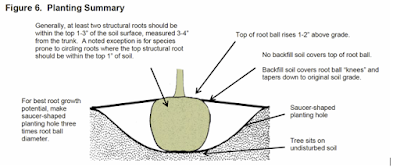How many times have you heard
from your friends, “I want to be able to walk out to my back yard and pick my
favorite fruit”. There are several things you need to consider before going to
the nursery and buying a fruit tree.
·
Climate
·
Size and Spacing
·
Soil Testing
·
Selecting
·
Planting
·
Watering
·
Pollenating
·
Harvesting
Climate
Select fruit trees that will
work well with Idaho’s zone 6 weather. Cold hardiness determines the minimum
temperature that tree can tolerate. The United States Department of Agriculture has developed a system that gives information about
the average minimum temperatures in a defined area. Microclimates may be warmer or colder and can impact tree survival and performance.
Viewing such websites as Idaho Average Last Frost Date will help in planting.
Size and Spacing
 |
Colorado State University Extension has a good chart on typical size of fruit trees. |
There are three sizes available for fruit trees;
dwarf (8 to 10 feet), semi-dwarf (10 to 20 feet), and full size (20 feet or over).
Dwarf and semi-dwarf make harvesting easier. Fruit trees require good drainage,
full sun, and soil with
a pH between 6.0 and 6.5. Trees do not do as well when located within your
lawn.
Soil Test
Soil test helps to determine
what nutrients are in the soil and which ones are low.
·
Nutrient levels
– i.e. nitrogen (N), phosphorus (P), potassium (K), calcium (Ca),
·
Soil pH
·
Organic matter
For more information on soil visit Idaho Master Gardener resources Chapter 5: Soils and Fertilizers.
Selecting Fruit Trees
You should always buy your trees from a reputable
nursery. Tony McCammon of University of Idaho recommends the following fruit
trees for home orchards. The links for the various fruit varieties are for information
only and does not endorse any nursery. Each tree has its own characteristics. These
websites will give you the general information to deciding which variety is for
you.
o
Cherries:
Planting a Fruit Tree
The best time to plant a
tree is during the dormant season. What type of root system will your tree
have; bare root, container, balled and burlapped? Each root system has a difference
in the way it is planted. The Arbor Day Foundation has instructions for each
root system.
·
Container
limit root spread. Be careful not to buy root that circle the tree ball. The
roots will need to be cut and will slow growth and stress the tree.
·
Balled and Burlapped it is important to remove the burlap before planting,
otherwise the burlap can cause serious harm to the tree.
 |
| Figure 6 Planting Summary |
Watering Trees
Over watering can slow root
growth, remove nitrogen and sulfur, and create an environment for crown and
collar rots. Under water leads to slow root development. Soil test will
indicate what soil type you have and how much water the soil can absorb at a
time. When checking your tree moisture level, check not only the backfill, but
the root-ball soil. It will take about 1 year for the tree roots to become
established. Below is a chart from Colorado State University Extension, GardenNotes
#635, table 1.
 |
| Click to enlarge. |
What is a tree caliper?
“A tree’s caliper measurement refers to the
diameter of the tree’s trunk. Therefore, a 3-inch caliper tree has a trunk that
is 3 inches across. A tree caliper is commonly used to calculate this
measurement, especially for trees that do not have very large diameters.”
https://www.reference.com/science/caliper-measurement-tree-e54c2db310afa001
https://www.reference.com/science/caliper-measurement-tree-e54c2db310afa001
Pollinating
There are 3 ways that a
fruit tree can be pollenated.
o
Pollination is
the transfer of pollen grains from the male to the female flower. Some trees
need another species pollen.
§
Example:
Bartlett pears needs pollination with a Bosc or Anjou pear.
o
Pollinators are
your insects that fly from flower to flower.
§
Example: Honey
bees, Mason, Blue Orchard bees, etc…
o
Self-Pollinating
tree does not need another to complete the pollination.
§
Example: Reliance
Peach
Harvesting
Harvesting depends on
several things. How old is your tree and it depends on the fruit tree? Do not
expect fruit for the first 2 years and if any fruit does appear in the first
year remove the fruit. You want all the
nutrition going to the roots. The
Idaho Preferred Products Calendar
will give you approximate harvest month. Each fruit tree has a harvest
time. Check the characteristics of the
fruit when buying your tree, for example, Reliance Peach ripens in early
August.
